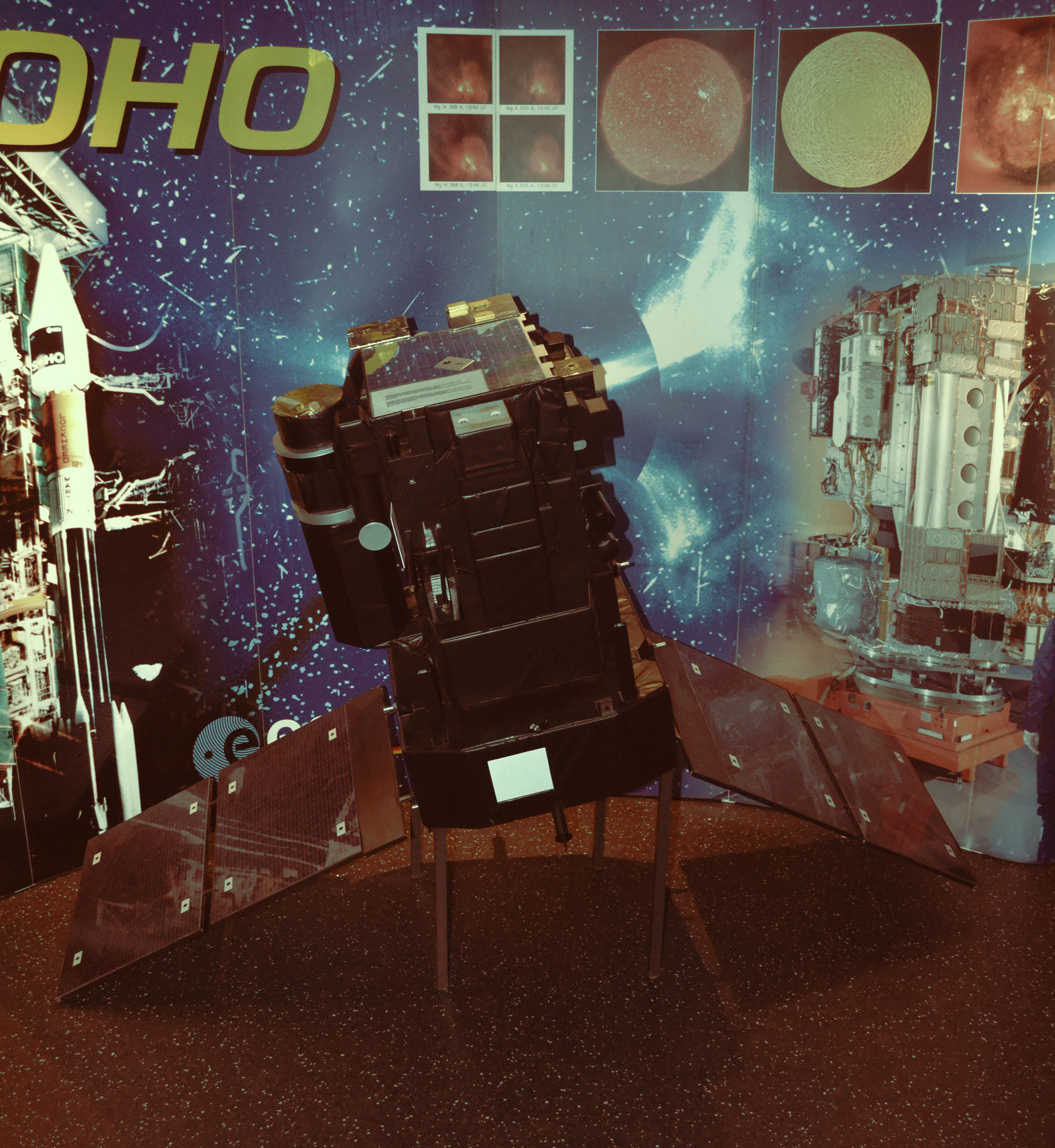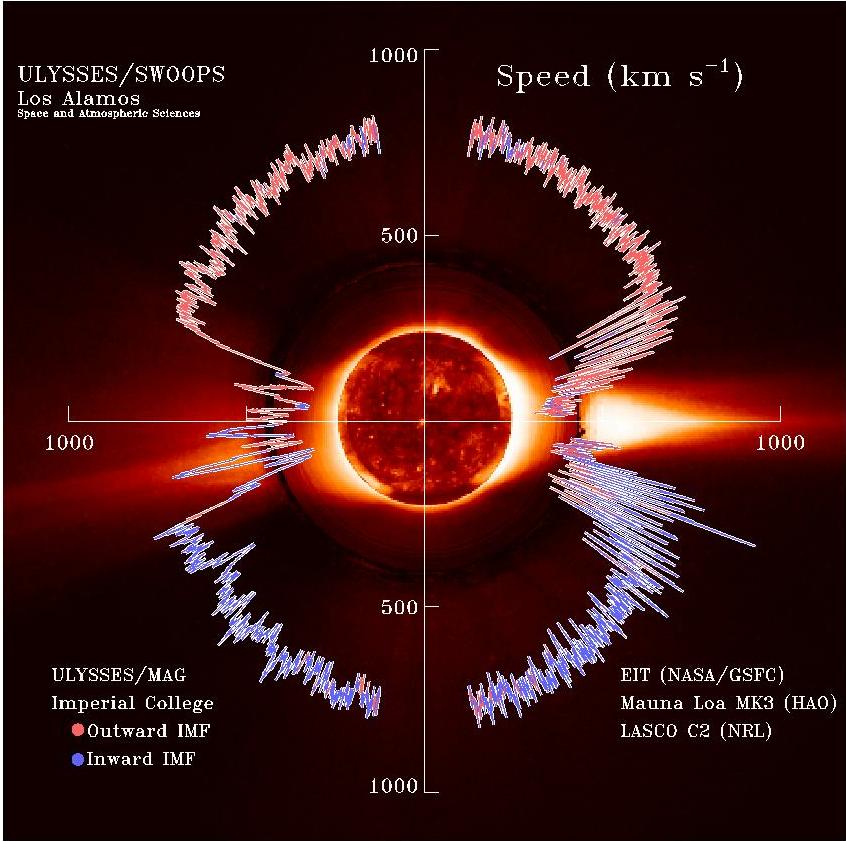|
GOES-U
GOES-19 (designated GOES-U prior to reaching geostationary orbit) is a weather satellite, the fourth and last of the GOES-R series of satellites operated by the National Oceanic and Atmospheric Administration (NOAA). The GOES-R series will extend the availability of the Geostationary Operational Environmental Satellite (GOES) system until 2036. The satellite is built by Lockheed Martin, based on the A2100 platform. The satellite was placed into service as the GOES-East position and GOES-16 was stored as backup on April 7th, 2025. Launch The satellite was successfully launched into space atop a SpaceX Falcon Heavy rocket on 25 June 2024 at 21:26UTC (5:26pm EDT local time at the launch site), from the Kennedy Space Center in Florida, United States. The redesign of the loop heat pipe to prevent an anomaly, as seen in GOES-17, was not expected to delay the launch as with GOES-T. GOES-19 also carries a copy of the Naval Research Laboratory's Compact CORonagraph (CCOR) instru ... [...More Info...] [...Related Items...] OR: [Wikipedia] [Google] [Baidu] |
Falcon Heavy
Falcon Heavy is a super heavy-lift launch vehicle with partial reusability that can carry cargo into Earth orbit and beyond. It is designed, manufactured and launched by American aerospace company SpaceX. The rocket consists of a center core on which two Falcon 9 boosters are attached, and a second stage on top of the center core. Falcon Heavy has the second highest payload capacity of any currently operational launch vehicle behind NASA's Space Launch System (SLS), and the fourth-highest capacity of any rocket to reach orbit, trailing behind the Space Launch System, SLS, Energia (rocket), Energia and the Saturn V. SpaceX conducted Falcon Heavy test flight, Falcon Heavy's maiden launch on 6 February 2018, at 20:45 Coordinated Universal Time, UTC. As a Boilerplate (spaceflight), dummy payload, the rocket carried Elon Musk's Tesla Roadster, a Tesla Roadster belonging to SpaceX founder Elon Musk, with a mannequin dubbed "Starman" in the driver's seat. The second Falcon Heavy laun ... [...More Info...] [...Related Items...] OR: [Wikipedia] [Google] [Baidu] |
GOES-T
GOES-18 (designated pre-launch as GOES-T) is the third of the "GOES-R Series", the current generation of weather satellites operated by the National Oceanic and Atmospheric Administration (NOAA). The current and next satellites of the Series (GOES-16, GOES-17, GOES-18, and GOES-19) will extend the availability of the Geostationary Operational Environmental Satellite (GOES) satellite system until 2037. The satellite is built by Lockheed Martin in Littleton, Colorado. It is based on the A2100A satellite bus and will have an expected useful life of 15 years (10 operational after five years in orbit replacement). Benefits and applications * Better detection of heavy rainfall and flash flood risks * Better fire detection and intensity estimation * Better monitoring of smoke and dust * Earlier warning of lightning ground strike hazards * Improved air quality warnings and alerts * Improved detection of low cloud / fog * Improved transportation safety and aviation route planning ... [...More Info...] [...Related Items...] OR: [Wikipedia] [Google] [Baidu] |
Geostationary Operational Environmental Satellites
The Geostationary Operational Environmental Satellite (GOES), operated by the United States' National Oceanic and Atmospheric Administration (NOAA)'s National Environmental Satellite, Data, and Information Service division, supports weather forecasting, severe storm tracking, and meteorology research. Spacecraft and ground-based elements of the system work together to provide a continuous stream of environmental data. The National Weather Service (NWS) and the Meteorological Service of Canada use the GOES system for their North American weather monitoring and forecasting operations, and scientific researchers use the data to better understand land, atmosphere, ocean, and climate dynamics. The GOES system uses geosynchronous equatorial satellites that, since the launch of SMS-1 in 1974, have been a basic element of U.S. weather monitoring and forecasting. The procurement, design, and manufacture of GOES satellites is overseen by NASA. NOAA is the official provider of both GOE ... [...More Info...] [...Related Items...] OR: [Wikipedia] [Google] [Baidu] |
GOES-17
GOES-17 (designated pre-launch as GOES-S) is an environmental satellite operated by the National Oceanic and Atmospheric Administration (NOAA). The satellite is second in the four-satellite GOES-R series (GOES-16, -17, - 18, and - 19). GOES-17 supports the Geostationary Operational Environmental Satellite (GOES) system, providing multi-spectral imaging for weather forecasts and meteorological and environmental research. The satellite was built by Lockheed Martin, based on the A2100A platform, and expected to have a useful life of 15 years (10 years operational after five years of standby as an on-orbit replacement). GOES-17 is intended to deliver high-resolution visible and infrared imagery and lightning observations of more than half the globe. The satellite was launched on 1 March 2018 and reached geostationary orbit on 12 March 2018. In May 2018, during the satellite's testing phase after launch, a problem was discovered with its primary instrument, the Advanced Baseli ... [...More Info...] [...Related Items...] OR: [Wikipedia] [Google] [Baidu] |
Space Weather Follow-On L1
Space Weather Follow On-Lagrange 1 (SWFO-L1) is a future spacecraft mission planned to monitor signs of solar storms, which may pose harm to Earth's telecommunication network. The spacecraft will be operated by the National Oceanic and Atmospheric Administration (NOAA), with launch scheduled for no earlier than September 2025. It is planned to be placed at the Sun–Earth Lagrange point, a location between the Earth and the Sun. This will allow SWFO-L1 to continuously watch the solar wind and energetic particles heading for Earth. SWFO-L1 is an ESPA Class Spacecraft, sized for launch on an Evolved Expendable Launch Vehicle Secondary Payload Adapter (ESPA) Grande ring in addition to the rocket's primary payload. The spacecraft's Solar Wind Instrument Suite (SWIS) which includes three instruments will monitor solar wind, and the Compact Coronagraph (CCOR) will monitor the Sun's surroundings to image coronal mass ejection (CME). A CME is a large outburst of plasma sent from the ... [...More Info...] [...Related Items...] OR: [Wikipedia] [Google] [Baidu] |
Launch Complex 39A
Launch Complex 39A (LC-39A) is the first of Launch Complex 39's three launch pads, located at NASA's Kennedy Space Center in Merritt Island, Florida. The pad, along with Launch Complex 39B, was built in the 1960s to accommodate the Saturn V launch vehicle, and has been used to support NASA crewed space flight missions, including the historic Apollo 11 moon landing and the Space Shuttle. Since 2014 the site has been leased by SpaceX and supports launches of the Falcon 9 and Falcon Heavy rockets. History Apollo program In 1961, U.S. President Kennedy proposed to the U.S. Congress the goal of landing a man on the Moon by the end of the decade. Congressional approval led to the launch of the Apollo program, which required a massive expansion of NASA operations, including an expansion of launch operations from the Cape to adjacent Merritt Island to the north and west. First named Launch Complex 39C, Launch Complex 39A was designed to handle launches of the Saturn V rocket, the ... [...More Info...] [...Related Items...] OR: [Wikipedia] [Google] [Baidu] |
Lockheed Martin A2100
The A2100 is a model of communications satellite spacecraft made by Lockheed Martin Space Systems. It is used as the foundation for telecommunications payloads in geosynchronous orbit, as well as GOES-R weather satellites and GPS Block IIIA satellites. Over 40 satellites use the A2100 bus. History The first satellite, AMC-1, was launched September 8, 1996, and has achieved 15-year on-orbit service life. Since 1996 there have been over 45 of the A2100 based satellites launched, with over 400 years of total on-orbit service. Other A2100 spacecraft include JCSAT-13 and VINASAT-2, which were launched May, 2012 on an Ariane 5 rocket, as well as Arabsat-6A and Hellas Sat 4/SaudiGeoSat-1 of Saudi Arabia's Arabsat-6G program. [...More Info...] [...Related Items...] OR: [Wikipedia] [Google] [Baidu] |
Solar And Heliospheric Observatory
The Solar and Heliospheric Observatory (SOHO) is a European Space Agency (ESA) spacecraft built by a European industrial consortium led by Matra Marconi Space (now Airbus Defence and Space) that was launched on a Lockheed Martin Atlas IIAS launch vehicle on 2 December 1995, to study the Sun. It has also discovered more than 5,000 comets. It began normal operations in May 1996. It is a joint project between the European Space Agency (ESA) and NASA. SOHO was part of the International Solar Terrestrial Physics Program (ISTP). Originally planned as a two-year mission, SOHO continues to operate after 29 years in space; the mission has been extended until the end of 2025, subject to review and confirmation by ESA's Science Programme Committee. In addition to its scientific mission, it is a main source of near-real-time solar data for space weather prediction. Along with Aditya-L1, Wind, Advanced Composition Explorer (ACE), and Deep Space Climate Observatory (DSCOVR), SOHO is one ... [...More Info...] [...Related Items...] OR: [Wikipedia] [Google] [Baidu] |
European Space Agency
The European Space Agency (ESA) is a 23-member International organization, international organization devoted to space exploration. With its headquarters in Paris and a staff of around 2,547 people globally as of 2023, ESA was founded in 1975 in the context of European integration. Its 2025 annual budget was €7.7 billion. The ESA Human and Robotic Exploration programme includes human spaceflight (mainly through participation in the International Space Station programme); as well as the launch and operation of missions to Mars and Moon. Further activities include science missions to Jupiter, Mercury, the Sun, Earth observation, Asteroid impact avoidance and Telecommunications missions, designing launch vehicles; and maintaining Europe's Spaceport, the Guiana Space Centre at Kourou (French Guiana). Further programmes include space safety, satellite navigation, applications and commercialisation. The main European launch vehicle Ariane 6 is operated through Arianespace ... [...More Info...] [...Related Items...] OR: [Wikipedia] [Google] [Baidu] |
Solar Wind
The solar wind is a stream of charged particles released from the Sun's outermost atmospheric layer, the Stellar corona, corona. This Plasma (physics), plasma mostly consists of electrons, protons and alpha particles with kinetic energy between . The composition of the solar wind plasma also includes a mixture of particle species found in the solar plasma: trace amounts of heavy ions and atomic nuclei of Chemical element, elements such as carbon, nitrogen, oxygen, neon, magnesium, silicon, sulfur, and iron. There are also rarer traces of some other nuclei and isotopes such as phosphorus, titanium, chromium, and nickel's isotopes 58Ni, 60Ni, and 62Ni. Superimposed with the solar-wind plasma is the interplanetary magnetic field. The solar wind varies in density, temperature and speed over time and over Solar coordinate systems#Heliographic, solar latitude and longitude. Its particles can escape the Sun's gravity because of their high energy resulting from the high temperature of t ... [...More Info...] [...Related Items...] OR: [Wikipedia] [Google] [Baidu] |






